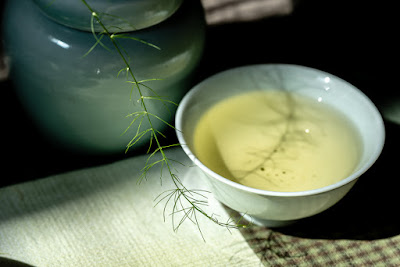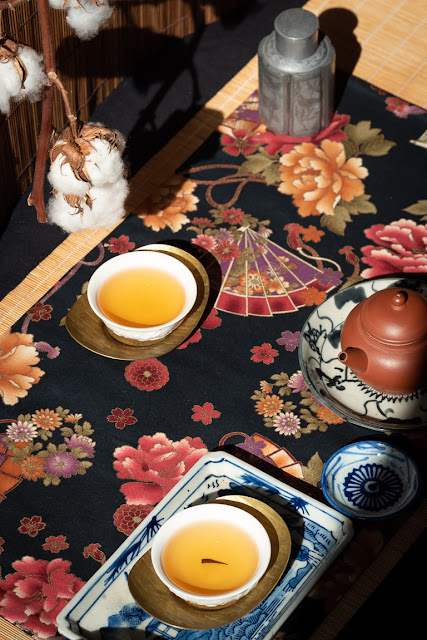 |
| Zhuo Yan Oolong from Shan Lin Xi, winter 2018 |
Comme tous les pays, la Chine n'est pas un territoire homogène, mais connait de fortes différences entre nord et sud, l'intérieur des terres et la partie costale. La géographie a un impact sur la culture et les personnes. Tout le monde sait que, de nos jours, les provinces côtières de la Chine qui commercent avec les autres pays sont plus prospères que les provinces de l'intérieur. Par contre, en Occident, on connait moins le fossé culturel entre la Chine du Nord et celle du Sud. Celui qui appliquerait la division française ou italienne (au nord il fait froid et on bosse, au sud il fait beau et on se la coule douce) aurait tout faux!
Les grandes plaines fertiles du nord sont le berceau de la Chine antique. En l'an 5 av. JC, seuls 10% des foyers chinois étaient dans le sud-est marécageux ou montagneux, chaud et humide. Les plaines du nord permettaient une agriculture céréalière simple et contrôlée par quelques grandes familles. C'est pourquoi on voyait les choses en grand dans le nord de la Chine. Les capitales y étaient immenses et carrées, comme des grands champs de céréale (blé, millet). Le pouvoir appartenait aux clans qui détenaient les plus grands terrains. Ils formaient l'aristocratie et avaient recours à des paysans peu éduqués et mal payés pour cultiver leurs terres. Et les revenus de l'Etat étaient surtout assis sur les rendements agricoles des terres les plus fertiles: celles du nord.
Les terres marécageuses du sud de la Chine étaient bien moins taxées et parfois gratuites, car elles étaient moins fertiles et plus morcelées. Chaque lopin nécessitait un travail préalable de drainage, de stabilisation... pour rendre la terre exploitable pour la culture du riz ou des fruits. Cela demandait un travail dur, plus technique et créatif. Mais de nombreux paysans Chinois préféraient être maitres de leur petite exploitation que serfs/locataires chez une grande famille. C'est pourquoi beaucoup allèrent s'installer dans le sud et dès 740 (dyanstie Tang), 40% des foyers Chinois se trouvaient au sud de la rivière Huai. Ce mouvement vers le sud s'accéléra en 1127 quand la dynastie Song du Nord se réfugia au Sud.
Les moines aussi préféraient installer leurs temples et monastères dans les montagnes, car ces endroits n'étaient pas taxés du tout, puisqu'il était très difficile d'y faire pousser de la nourriture. Le sud de la Chine fut donc l'eldorado des Chinois les plus entreprenants et résistants à l'autorité du pouvoir central et des grandes familles. Il en résulte donc un tempérament et un état d'esprit très différent selon qu'on vit au nord ou au sud de la Chine. Au nord, à Pékin notamment, on pense tout très grand (grandes plaines, grands projets, grandes entreprises...). Le pouvoir est centralisateur et concentré en peu de mains. Les solutions et les produits sont standards comme les céréales. Au sud, par contre, on pense PME, liberté d'entreprendre, indépendence, créativité...
 |
| Photo de Rattana Vandy |
En effet, depuis la dynastie Ming à nos jours, dans le nord de la Chine, on aime surtout boire le thé vert. A la base, ce sont des feuilles de théier séchées très rapidement pour qu'elles n'oxydent pas. Leur transformation est donc minimale et ne demande pas trop de savoir-faire. Leurs arômes sont frais et la qualité dépend surtout de la taille des bourgeons et du moment de la récolte: plus on récolte tôt au printemps, plus le temps est frais et donc plus les arômes sont fins. En terme de thé, c'est ce qui se fait de plus standard ou de plus facile à classifier (par date de récolte ou nombre de feuille au kg).
Le génie des fermiers de Wuyi est d'avoir pensé le Oolong comme des Chinois du sud. Au lieu de faire simple, ils allaient faire compliqué. Au lieu de cultiver de grandes plantation en plaine, ils allaient cultiver les théiers sur des petites parcelles pentues et rocailleuses de Wuyi. Mais afin de rester compétitif, au lieu de récolter les feuilles au stade de bourgeon, ils attendraient qu'elles soient matures, mais encore tendres. Le climat de ces monts du sud, bercés par une rivière, permet justement que ces théiers ne reçoivent pas trop de soleil et que l'air soit humide afin de bien préserver la fraicheur des feuilles. (On retrouve ces mêmes principes pour le Oolong de haute montagne de Taiwan). Ensuite, les fermiers oxydent les feuilles avec beaucoup de savoir-faire pour obtenir un degré d'oxydation qui exprime le mieux leur caractètre. Et le process se conclut par une torréfaction intense mais délicate qui préserve la fraicheur des arômes pendant des dizaines d'années!
Ils obtinrent un thé radicalement différent du thé vert. En fait, ils n'obtinrent pas seulement un thé, mais des dizaines, voire des centaines de thés différents selon le pic où il est planté, quel cultivar est utilisé, quel style de torréfaction est appliqué... Le Oolong est donc le thé le moins standardisé, le plus individuel. Il y en a pour tous les goûts et toutes les bourses. Mais la fierté et le succès des fermiers de Wuyi, c'est que la qualité de leur Yan Cha fut reconnue très rapidement. Dès la dynastie Qing, on a des actes de vente qui montrent que les meilleures feuilles de Wuyi, le Da Hong Pao, se vendaient au prix de l'or!
 |
| Photo de Rattana Vandy |
De plus, le Oolong n'est pas une boisson de pouvoir avec laquelle on impressionne ses invités. Pour cela, son infusion est beaucoup trop technique et facétieuse. Quand Xi Jinping invite un autre chef d'Etat à boire du thé, il le fait toujours préparer par un maitre de thé (ou une jolie maitresse de thé)! Voilà comment on aime boire le thé dans le nord de la Chine, préparé par une tierce personne à votre service. Dans le sud, au contraire, le thé est bu à la manière de Chaozhou, en petits groupes de trois personnes de même rang. Souvent, le chef d'entreprise fait le thé pour ses clients. C'est fait pour être plus personnel et tisser de meilleurs liens humains.
Conclusion: de tous points de vue (culture, fabrication, préparation, vente), le Oolong est l'expression de l'âme créative et rebelle de la Chine du sud. Et c'est aussi pour cela que je l'aime!!!































































